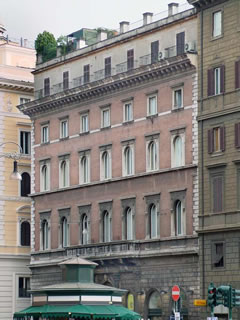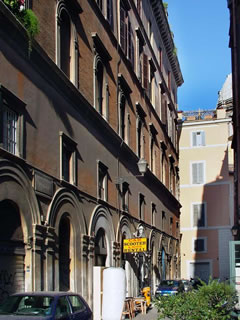Pichi - Manfroni - Lovatti Palace
in alley dei Bovari - Corso Vittorio Emanuele II, 154 - via del Paradiso 4, Rome
Historical
evocations, artistic treasures, and the splendor of different eras
surround Manfroni Lovatti Palace, just steps from Piazza Navona, in
a sort of unique aura. This palace's fascinating past reflects the
transformations of Rome during the reign of Umberto I, when the need to
celebrate the new capital of unified Italy led to the redesign of the city
center. The building's original layout, attributed to Leon Battista
Alberti and by others to Pietro Rosselli, dates back to the late 15th
century, when Girolamo Pichi, Master of the Roads,
commissioned a sumptuous palace on the block between Vicolo dei Bovari,
Via del Paradiso, Via de' Baullari, and Via di S.
Pantaleo, almost opposite the Massimo family's property.
In the
17th century the palace passed to the Manfroni family, who still owned it
in the 18th century; in the following century it was left to the charitable
organization Pia Casa degli orfani di Santa Maria in Aquiro, from which
it was purchased on 25 January 1862 by Filippo Lovatti (1822-1893), son
of Matteo Lovatti (1770-1849), and then sold to the Banca Romana,
after about fifteen years.
In 1881, due to construction work on Corso
Vittorio Emanuele II, the main fašade was demolished and rebuilt further
back by engineer Ciriaco Baschieri Salvatori in the Neo-Renaissance style we
admire today. The Lovatti coat of arms, located above the main
entrance, was thus destroyed. The large portal, which opens onto a stately
entrance, is striking. The symmetrical fašade, punctuated by arched windows
with architraves, is pleasing in its rigorous simplicity. The entrance features
a frescoed vaulted ceiling. The attic features a double living room, embellished
with a coffered ceiling and an antique stone fireplace. The living area
continues with the dining room and the adjacent, spacious kitchen, while the
sleeping area consists of four bedrooms with balconies offering a picturesque
view of the rooftops of the historic center. Three bathrooms are furnished in
fine marble.
The terrace above, connected to the penthouse by an internal
staircase, is highly enjoyable and offers a magnificent view of the historic
center. The view extends from the magnificent dome of Sant'Andrea della
Valle in the foreground to the Quirinale Tower and the dome of
the Pantheon, just beyond. The 60 square meter terrace offers a true
outdoor living room, enhanced by Rome's renowned mild climate.


Tradition attributes it to Leon
Battista Alberti, and this is his only work in Rome, but Professor
Tornaletti argued in a monograph that Alberti was already dead by the time
this palace was built. However, it may have been built later based on his
designs. With the opening of Corso Vittorio Emanuele, the rear section was
demolished and the fašade, facing Palazzo Massimo, was rebuilt with a
design similar to the original, but with variations. The original part of
the palace faces the narrow Vicolo dei Bovari; some pillars, a
corner base, and a ground-floor window can still be seen. On the frieze of
the arched windows on the first floor, on the fašade overlooking Vicolo
dei Bovari, is the inscription: "Hieronimus picus",
indicating that the palace was once owned by the famous Pichi merchant
family, who owned several houses in Rome. Their coat of arms is also
visible.


Lovatti family - historical notes
Maurilio Lovatti - main index of online papers
e-mail: maurilio@lovatti.eu